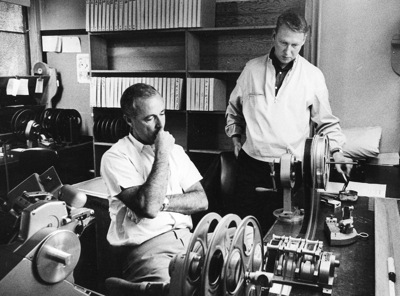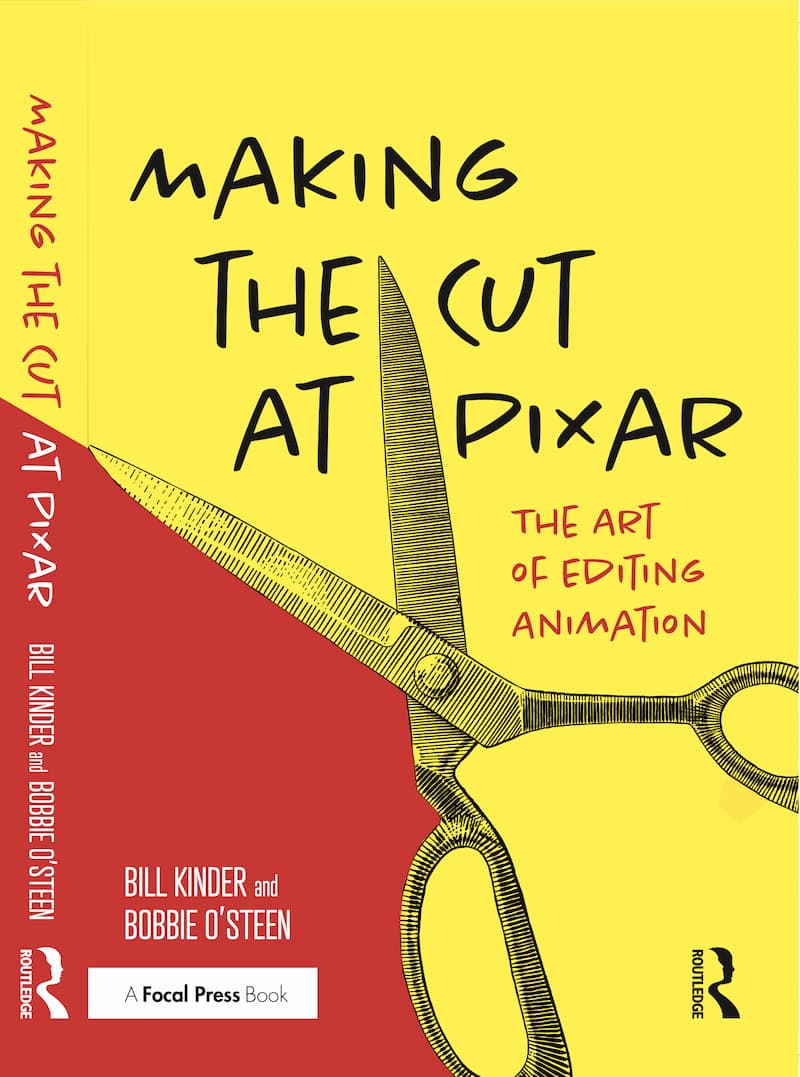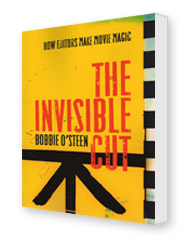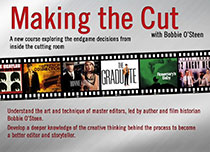Legendary film editor Sam O’Steen (The Graduate, Chinatown) talks candidly with wife Bobbie O’Steen about his work in the cutting room and behind the scenes on some of the most influential movies in motion picture history.
Sam began what turned out to be a thirty-year collaboration with director Mike Nichols when he went to work on Who’s Afraid of Virginia Woolf?. This movie, based on a hit Broadway play, stars Richard Burton and Elizabeth Taylor.
The following is an excerpt from his discussion of this groundbreaking movie. (Bobbie’s questions are in italics.)
You said when you were cutting Virginia Woolf, it was like a bucket of worms, that it just went on and on.
It had a very fast motor and you had to keep it going. Once you opened that up, you just had to go with it.

Sam and Mike Nichols deep in thought at editing bench on Who's Afraid of Virginia Woolf?
What was the biggest technical difficulty?
All the overlapping dialogue. Mike called me down to the set and said, “Two people are talking all the time and I want them to overlap, how do I do it?” I said, “Use two cameras, you know, camera on him, camera on her, you got one track” But one of them wouldn’t do it, I think it was Burton, cause he said, “I can’t act when you do that, why don’t you shoot one, then the other?” I said, “Then I’d have to cut the track first.” Mike said, “Do whatever you have to do.” So this is what I did: When George and Martha were talking at the same time, I mixed their two tracks together. I did a dub on it, and it came out right, bang, the scene timed out about right, so then I coded the soundtrack [had numbers printed on the edge to match the picture’s code numbers, so that they were both in sync]. I did it twice to match both actors, George’s takes and Martha’s takes. So say George is speaking Latin and Martha is wailing away, and they’re talking between them – well, when I started cutting first to her, then to him, it didn’t matter if they overlapped, they would always be in sync. I could cut anyplace I wanted to.
You just invented that, basically.
I guess so.
You developed a saying around that time, to remind a director not to become too attached to a moment, or a scene.
“Movie first, scene second, moment third.” That is the order of importance for everything.
So everything has to be justified in terms of how it serves the movie, you can’t hold onto a scene – or moment – just because you like it.
Right.
Tell about the walk to the tree.
If you remember, after the big squabble Honey [Sandy Dennis] and Martha go running off to the bathroom and George takes a walk to the tree. It seems like a long time where nothing was happening, so I asked Mike why he did that and he said you have to have a break after all the fighting. You can’t be afraid to be boring. Then we could start building up to the fighting again, and blast away.
That was a lesson.
Yeah, all movies are – should be – a series of arcs. You start it at one level, build to a climax, then you have to come down and start over again, there’s nowhere else to go. If you stay at one level, it won’t sustain. And Mike and I would refer to “the walk to the tree” on other pictures, when we needed to let it breathe, let it build up again.
Where did you shoot the walk to the tree and all the other exteriors?
At Smith College in Northhampton, Massachusetts. When we arrived it was September, which is still summer in California. Well, it sure wasn’t in Massachusetts, and we were shooting a lot of nights. It was cold, boy, I can tell you that. We bought all the long underwear in town.
You witnessed something special on the studio lot.
I was walking behind Burton across an empty sound stage – I was about twenty yards behind him – but he didn’t know I was there. Then suddenly he saw this shaft light coming down right in front of him, there must have been a hole in the ceiling. So he stepped into the light, looked up and did this amazing speech, I guess it was from Hamlet. All I know is it sent chills down my spine. I couldn’t believe it. Then he just walked on, as if nothing happened. He never knew I’d been watching him.
Nichols must’ve been worried about Elizabeth Taylor’s age, since she was supposed to play about twenty years older.
We shot make-up tests ‘til they were coming out of our ears. First they put lines every place, and she looked old enough, but you saw the pencil lines. Mike sweated that out quite a bit, but in the end they didn’t put much make-up on her. She did gain weight for the part, and had a double chin, which helped.
Along with the smudgy mascara, lipstick and the gray-streaked wig. And she wasn’t difficult, she wasn’t vain about it?
No, she was really nice. She was into it. She even picked this one blouse that bunched up so her stomach would show. And she would make sure she smeared her lipstick so it would match the previous shot, stuff like that. She really didn’t care how bad she looked, she was a pro. There was also a scene we shot outside the roadhouse where she was trying to hit George and he hurled her away. She kept hitting her head against the car, and didn’t complain, but they did have a doctor examine her to make sure she was okay.
Was Mike worried about her acting abilities?
Well, he knew what she was, you don’t fool him about that kinda shit. And he would say, “She doesn’t make this moment.” And he’d have her do it again and again.
Was she better than he thought she’d be?
I think so.
When I saw it recently I didn’t remember how good she was.
Me neither, boy.
Sandy Dennis was great, too. She was actually pregnant and then miscarried during shooting. Was it when she fell in that scene?
I heard Mike say he thought that might have caused it, but he did tell her to be careful.
What did you think of George Segal’s performance?
I liked him okay, but, well, just look at the scene where he and Burton were drunk. Burton didn’t play drunk, Segal did. That’s the difference.
Warner had to be talked into hiring Richard Burton.
But he was dynamite.
Burton – the moody Welshman – was tougher to work with than his wife.
Oh yeah.
What would he do?
He’d just walk off the set if he got mad. He didn’t give a fuck. If anybody could intimidate Mike, it was Richard Burton.
Because?
[Imitating Burton’s deep voice] “What do you mean I don’t do this?” [Growls]
But he was usually right.
What did Taylor do when he did that?
If she didn’t agree, she’d argue with him.
There was some of George and Martha in the Burton/Taylor relationship: the public fighting, the game playing, the love/hate interdependency…
So I heard. But they got along fine, everybody got along. It’s just that Mike used to get pissed because they would take long lunches. They had a dressing room up in the main building, this big suite, and they partied.
Another thing they had in common with George and Martha: the drinking. When they were called back to the set after lunch, what would they do?
They’d say, “We’ll be down.” Meanwhile, Mike was going crazy. He’d walk around saying, “Cocksuckers, I hate their fuckin’ guts,” and cry to me that they were costing him time. When they finally came back late, they’d just ignore it all, be real nice. “Hey, Mike, old buddy, sorry we’re late, okay let’s shoot.”
What did they drink?
Lancers wine. Burton would drink brandy to get drunk, but not while they were shooting.
So they wouldn’t come back drunk, just a little buzzed.
Yeah. But sometimes they wouldn’t come back ‘til five o’clock and they had in their contract that they couldn’t work past six o’clock.
God, that’s horrible.
Yeah, if you’re the director it is. Mike ended up being thirty days over schedule and doubling the budget. The studio thought about kicking Mike off the movie. They tried, but they knew if they fired Mike, the Burtons would both walk.
Did Mike and Jack Warner ever have a confrontation?
Warner wouldn’t fight with anyone directly. But in one scene where George rang the doorbell, Martha said, “Fuck you” in the play, Mike changed it to “Screw you,” and Warner said we had to put “Goddamned you” in her mouth, which is a long way from “Fuck you” and “Screw you.” And Mike tried to fight that. Also, Mike had been going to New York on the weekends doing commercials with Elaine May, then flying back Monday morning, so Warner said, “Is he doing that or doing this?”
There was also a fight over the composer.
Ernie signed Alex North as the composer. He was considered tops in Hollywood, but Mike didn’t want him, he wanted Andre Previn. I said, “Mike, they already signed him [North] and that’s money, don’t fight with Warner, don’t push him into a corner.” But Mike didn’t give a shit, he wanted Andre Previn. So he kept fighting and that was the last straw, that’s what finally did it. That was just before Warner threw him off the lot. Mike and I were working in the cutting room, we’d just finished shooting a couple weeks before, when they told him he had four more days to finish the movie.
And Mike didn’t fight it?
Sure, he yelled about it, but there was nothing he could do. The guards were told not to let him in.
Yet Sinatra got away with so much waste, so much bullshit.
Yeah. Well, Sinatra had his own unit on the lot, it was “Sinatra Productions.” And with Mike it was about a lot of things that had been building and building.
Mike said it was standard practice for Warner to fire directors because he liked to have his pictures finished as quickly as possible and let his departments do that.
That’s true to a degree, but Warner would’ve given him at least a little more time if he hadn’t been pissed.
So you worked day and night for those four days, and finished before he was kicked off the lot?
I remember at one point I was sitting on a stool, laughing at something, and I was so tired I actually blacked out. And then for the last reel, I met Mike at the studio at 5:00 in the morning and we worked ‘til midnight. I was just a walking zombie. I’d say, “I got to take a walk to clear my head just for a minute,” but we finished. Then they wouldn’t even let Mike mix [supervise the process where technicians combine music, sound effects, and dialogue into a single sound track]. I mixed the picture and at the end of each day I’d call Mike and hold the phone up so he could listen. And he would make comments like, “Can you bring the music down there, I don’t think we need that sound.” We did that every day for about a month.
Mike said that was a “remarkably brave thing” for you to do because if Warner had found out he would have blackballed you from every studio.
It could have happened, I guess. It’s amazing really to think that there were seven or eight guys [studio heads] who could just call each other and that would be the end of you.
Did Warner worry about the movie being too talky?
No, just too vulgar. But Warner did stand behind the movie and kept most of the dialogue the way it was.
What did you think of the movie?
I wasn’t worried about it, but I didn’t know what we had. We didn’t know.
Tell about the screening at the Pantages Theatre.
It was the world premiere, it was a full house, invited people and press, and Mike and I sat in the back row. Well, like I said, we had no idea what we had and Mike was a basket case. So the picture started and he said, “That’s a light print. Jesus!” And I said, “Come on, Mike, settle down.” But he kept moaning and groaning throughout the screening, that it was too dark and too light and at the end of it, Mike said, “Let’s get out of here. I don’t want to see anybody.” So we ran out, got in his car, and drove away. And everybody was looking for him, looking all over. But he just couldn’t face them, he thought it was a disaster. But the audience had been great, they’d laughed throughout the movie.
Then the movie came out and you got raves.
They loved the movie, they just loved it. The reviews called it the best movie ever made, said that Mike Nichols was a genius.
How did Mike deal with all that?
Very well. [Laughs]
When you see the movie now, anything you would change?
Yeah, a few cuts I would’ve fixed. But, basically, my first cut is the final cut.




